《馬爾科夫過程導論》是2009年4月1日由世界圖書出版公司出版社出版(美國) 丹尼爾斯特魯克編著的實體書。
基本介紹
- 書名:馬爾科夫過程導論
- ISBN:7510004489, 9787510004483
- 出版社:世界圖書出版公司出版社
- 出版時間:2009年4月1日
圖書信息,作者簡介,內容簡介,目錄,
圖書信息
外文書名: An Introduction to Markov Processes
平裝: 171頁
正文語種: 英語
開本: 24
條形碼: 9787510004483
尺寸: 22 x 14.6 x 0.8 cm
重量: 240 g
作者簡介
作者:(美國) 丹尼爾斯特魯克 (Strook.D.W.)
內容簡介
《馬爾科夫過程導論》講述了:To some extent, it would be accurate to summarize the contents of this book as an intolerably protracted description of what happens when either one raises a transition probability matrix P (i.e., all entries (P)o are nonnegative and each row of P sums to 1) to higher and higher powers or one exponentiates R(P - I), where R is a diagonal matrix with non-negative entries. Indeed, when it comes right down to it, that is all that is done in this book. However, I, and others of my ilk, would take offense at such a dismissive characterization of the theory of Markov chains and processes with values in a countable state space, and a primary goal of mine in writing this book was to convince its readers that our offense would be warranted
目錄
Preface.
Chapter1 RandomWalksAGoodPlacetoBegin
1.1.NearestNeighborRandomWlalksonZ
1.1.1.DistributionatTimen
1.1.2.PassageTimesviatheReflectionPrinciple
1.1.3.SomeRelatedComputations
1.1.4.TimeofFirstReturn
1.1.5.PassageTimesviaFunctionalEquations
1.2.RecurrencePropertiesofRandomWalks
1.2.1.RandomWalksonZd
1.2.2.AnElementaryRecurrenceCriterion
1.2.3.RecurrenceofSymmetricRandomWalkinZ2
1.2.4.nansienceinZ3
1.3.Exercises
Chapter2 Doeblin'STheoryforMarkovChains
2.1.SomeGeneralities
2.1.1.ExistenceofMarkovChains
2.1.2.TransionProbabilities&ProbabilityVectors
2.1.3.nansitionProbabilitiesandFunctions
2.1.4.TheMarkovProperty
2.2.Doeblin'STheory
2.2.1.Doeblin'SBasicTheorem
2.2.2.ACoupleofExtensions
2.3.ElementsofErgodicTheory
2.3.1.TheMeanErgodicTheorem
2.3.2.ReturnTimes
2.3.3.Identificationofπ
2.4.Exercises
Chapter3 MoreabouttheErgodicTheoryofMarkovChains
3.1.ClassificationofStates
3.1.1.Classification,Recurrence,andTransience
3.1.2.CriteriaforRecurrenceandTransmnge
3.1.3.Periodicity
3.2.ErgodicTheorywithoutDoeblin
3.2.1.ConvergenceofMatrices
3.2.2.AbelConvergence
3.2.3.StructureofStationaryDistributions
3.2.4.ASmallImprovement
3.2.5.TheMcanErgodicTheoremAgain
3.2.6.ARefinementinTheAperiodicCase
3.2.7.PeriodicStructure
3.3.Exercises
Chapter4 MarkovProcessesinContinuousTime
4.1.PoissonProcesses
4.1.1.TheSimplePoissonProcess
4.1.2.CompoundPoissonProcessesonZ
4.2.MarkovProcesseswithBoundedRates
4.2.1.BasicConstruction
4.2.2.TheMarkovProperty
4.2.3.TheQ-MatrixandKolmogorov'SBackwardEquation
4.2.4.Kolmogorov'SForwardEquation
4.2.5.SolvingKolmogorov'SEquation
4.2.6.AMarkovProcessfromitsInfinitesimalCharacteristics..
4.3.UnboundedRates
4.3.1.Explosion
4.3.2.CriteriaforNon.explosionorExplosion
4.3.3.WhattoDoWhenExplosionOccurs
4.4.ErgodicProperties
4.4.1.ClassificationofStates
4.4.2.StationaryMeasuresandLimitTheorems
4.4.3.Interpretingπii
4.5.Exercises
Chapter5 ReversibleMarkovProeesses
5.1.R,eversibleMarkovChains
5.1.1.ReversibilityfromInvariance
5.1.2.MeasurementsinQuadraticMean
5.1.3.TheSpectralGap
5.1.4.ReversibilityandPeriodicity
5.1.5.RelationtoConvergenceinVariation
5.2.DirichletFormsandEstimationofβ
5.2.1.TheDirichletFormandPoincar4'SInequality
5.2.2.Estimatingβ+
5.2.3.Estimatingβ-
5.3.ReversibleMarkovProcessesinContinuousTime
5.3.1.CriterionforReversibility
5.3.2.ConvergenceinL2(π)forBoundedRates
5.3.3.L2(π)ConvergenceRateinGeneral
5.3.4.Estimating
5.4.GibbsStatesandGlauberDynamics
5.4.1.Formulation
5.4.2.TheDirichletForm
5.5.SimulatedAnnealing
5.5.1.TheAlgorithm
5.5.2.ConstructionoftheTransitionProbabilities
5.5.3.DescriptionoftheMarkovProcess
5.5.4.ChoosingaCoolingSchedule
5.5.5.SmallImprovements
5.6.Exercises
Chapter6 SomeMildMeasureTheory
6.1.ADescriptionofLebesgue'sMeasureTheory
6.1.1.MeasureSpaces
6.1.2.SomeConsequencesofCountableAdditivity
6.1.3.Generatinga-Algebras
6.1.4.MeasurableFunctions
6.1.5.LebesgueIntegration
6.1.6.StabilityPropertiesofLebesgueIntegration
6.1.7.LebesgueIntegrationinCountableSpaces
6.1.8.Fubini'sTheorem
6.2.ModelingProbability
6.2.1.ModelingInfinitelyManyTossesofaFairCoin
6.3.IndependentRandomVariables
6.3.1.ExistenceofLotsofIndependentRandomVariables
6.4.ConditionalProbabilitiesandExpectations
6.4.1.ConditioningwithRespecttoRandomVariables
Notation
References
Index

